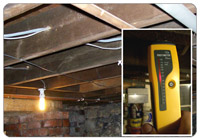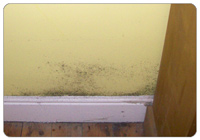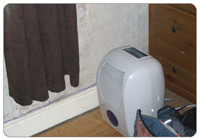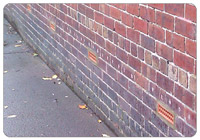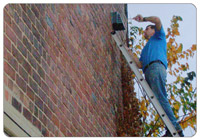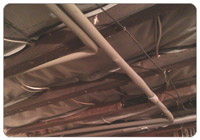
Dampness, condensation and mould in an Otley home
The problem
An end-terrace house in Otley suffers from condensation and mould. The owners have asked us to look at the possibility of installing wall and loft insulation as a way of making the property warmer and so reducing mould dampness and condensation.
Our assessment
As the property was around 100 years old and did not have cavity walls then cavity wall insulation was not an option. We also felt there was very limited scope for improving the insulation in the loft as the loft had been converted to a bedroom.
However it was clear that the home suffered from dampness, condensation and mould. Damp meter readings in the cellar showed high moisture levels in the timbers and in the long term this would allow wet rot or dry rot to flourish. Mould was evident on the walls of the ground floor and on bedroom walls.
The home is occupied by a family of four and it was our view that there was insufficient ventilation in the home. There was clearly an imbalance between the moisture being produced from normal family activities like cooking, washing, drying clothes etc. against the amount that was being removed through natural ventilation.
Our solution
We proposed a number of measures to introduce effective ventilation and increase insulation in a cost effective way.
The cellar had a tumble drier in it and we felt it was very important to address this part of the house. A damp proofing company had installed a chemical damp proof course at some point in the past but we recommended installing air bricks along the side of the house to bring fresh air into the cellar.
Ventilating the cellar in this way allows the floor timbers to dry out, but can also make the ground floor colder since draughts will now be able to permeate through the floor boards. To stop this we installed quilt insulation between the joists of the ground floor (i.e. the ‘ceiling’ of the cellar) which was held in place with a breathable membrane. We also took the opportunity to insulate all bare water pipes – this stops heat being wasted from the central heating and reduces the chance of the pipes freezing during winter.
On the ground and first floors we installed two heat recovery ventilation units. In operation these units provide a constant flow of air and are virtually silent.
In appearance they can be easily mistaken for a conventional extractor fan but they operate in a very different way. Stale air expelled from the home is used to pre-heat fresh air drawn in from outside, and because they are designed to be in constant operation the amount of air being drawn into the house is barely noticeable. Over time however the effect can be dramatic.
See our page on solutions for condensation problems for further information.
High humidity + inadequate ventilation
= damp, condensation, mould

UK government advises:

